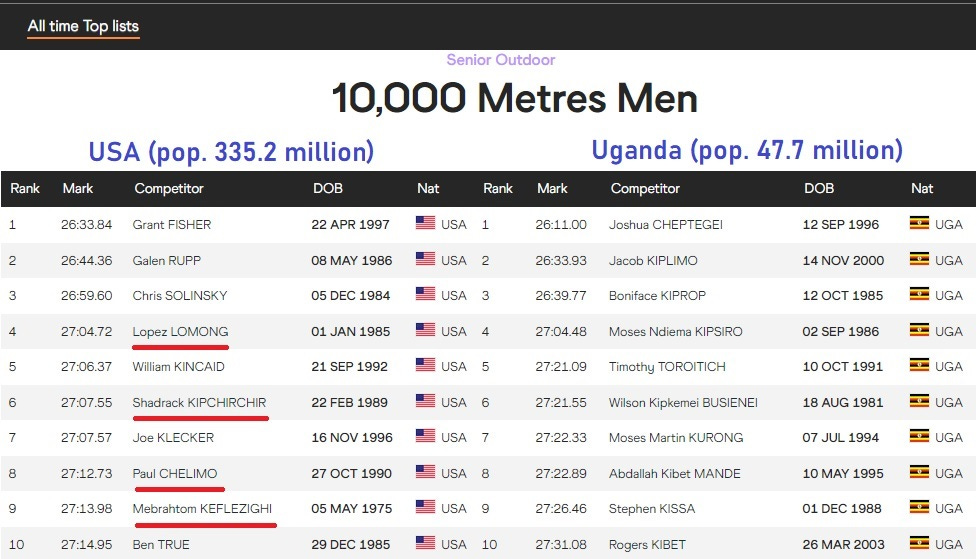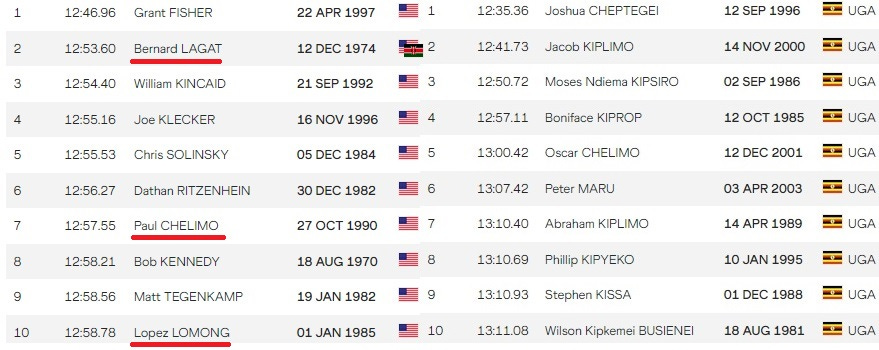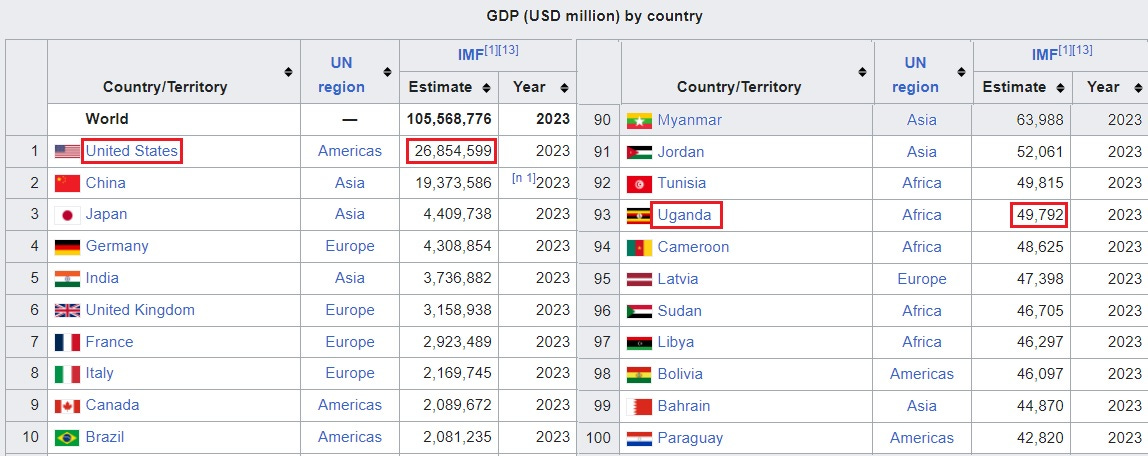How high can Ugandan runners rise compared to their neighbors? And how much co-dominance would be too much?
In ten years, the top tier of the all-time distance lists might dramatically different owing to this one country
Uganda is an African country that was under British rule until 1962 and is shaped much like a mirror image of the U.S. state of Missouri, albeit a version with its northernmost portion having been warped by climate change in the form of a stiff easterly breeze. It is preparing to serve as an oil spigot for offshore interests in the form of the East African Crude Oil Pipeline.
Uganda is about one-third larger than Missouri, including the 15 percent of its surface territory that consists of water, but has nearly eight times the Show Me State’s population (and now that social media has thrown all of us* into an inglorious and everlasting Show You State, I bet everyone in Missouri now hates that motto). From these facts, you may deduce, if you wish, that Uganda is significantly more crowded than Missouri. But it is less crowded than Delaware, which has both more persons per square mile (over 500) and more political criminals per White House wing than Uganda.
If you follow running, you surely know of Joshua Cheptegei, who holds the world records in both the 5,000 meters and the 10,000 meters, and almost certainly know of Jacob Kiplimo, the 22-year-old who stands sixth and eighth all-time, respectively, in those same events with times of 12:41.73 and 26:33.93 and holds the world record in the half-marathon (57:31). Both were supposed to compete in the impending 2023 World Athletics Championships, but Kiplimo withdrew last week citing a bitchy hamstring.
Stephen Kiprotich won back-to-back global marathon gold medals in winning the 2012 Olympic Marathon in London and the 2013 World Athletics Championships Marathon in Moscow, a city that apparently failed to submit its bid for the 2023 edition in a timely fashion. And a coterie of genuine geeks—just chronically hopeless no-life losers who would be wise to shut up about what they know at this point—will even recall 12:57/26:39 man Boniface Kiprop, who has been retired for nearly ten years and was sometimes miscountried as Kenyan on the Letsrun forums.
Uganda has produced three marathoners who have run faster than Khalid Khannouchi’s musty American record of 2:05:38—Kiprotich not among them—and five who have bettered Ryan Hall’s moldering half-marathon AR of 59:46. But the ongoing on-the-track éclat of Cheptegei and Kiplimo demands a comparison of the men of the U.S.A. and the men of Uganda in that environment, beginning with the longest track event, the 10,000 meters.
I underlined the four Americans who were born in countries in East-Central Africa, not so much because this helps clarify the comparison since Uganda is in East-Central Africa but to show how easy it is for someone with access to MS Paint to become a klaxon of white supremacy and make four legitimate Americans feel unsafe.
You may notice that, as in the marathon, Uganda more than holds its own in the 10,000 meters compared to the U.S. until around the fourth shared row, when Uganda's pronounced depth problem becomes manifest. This also shows up in the 5,000 meters with delicious precision.
Uganda’s problem—assuming one even sees having fewer 13:00- and 27:15-level athletes than the U.S. does as a problem—is not a lack of human capital per se, as the examples of Kenya (population 53 million) and to a lesser extent Ethiopia (population 120 million) have emphatically demonstrated. The issue is that Uganda’s male running corps is only now nearing the point Kenya’s and Ethiopia’s men were reaching in the late 1980s and early 1990s.
While running history is rich in the exploits of individual East African standouts dating to the 1960s, such as Kenya’s Kipchoge Keino, Ethiopia’s Abebe Bikila and Miruts Yifter, and Tanzanian Filbert Bayi, Kanya and Ethiopia did not achieve anything close to their current group-level prominence on the track until the 1990s (the roads were a different story). This prominence shortly translated to dominance. A cynic could attribute this timing to, say, erythropoietin (EPO) distributors from Europe (mostly Italians like Gabrielle Rosa and Retardo Canova) posing as sports agents and coaches descending on these countries once that drug became available c. 1990 and enriching themselves on the back of the achievements of wildly doped-up East Africans for an entire gleeful decade before the September 2000 introduction of a direct test for EPO put a slight burp in the charade. What an optimist might say, I have no earthly idea.
It’s fair to hypothesize that Uganda’s standing on the global economic stage plays at least a small role in its lack of historical emphasis on international sports. Uganda’s gross domestic product is well over five hundred times lower than that of the United States, although it’s about even if the contributions to the American largesse from the instigation of needless wars in Africa and elsewhere, perpetual drone-strike campaigns in Africa and elsewhere, and overthrowing governments and installing coup-leaders in Africa and elsewhere are omitted.
Uganda at the moment has only 49 entries on the all-time World Athletics men’s 5,000-meter list and only 65 on the corresponding 10,000-meter list. And speaking of World Athletics, it’s a good thing that organization isn’t big on Pride Month stuff—probably reflecting how much of a World Athletics stakeholder China has become—or else it would have to ban Uganda’s athletes from competing in the upcoming champs for human-rights offenses. In May, Uganda’s president, Yoweri Museveni, signed a law that makes same-sex relationships punishable by life in prison and in some instances a capital crime.
It would take a lot more balls in this (Bill) Gatesblown and (Larry) Finkified geopolitical climate to ban an East African country from a single worldwide gathering than it would to categorically debar Russia and Belarus from access to water and oxygen. I’m not saying that any athletes should be banned for having leaders who need to be tossed into massive vats of acidic vomit and then sodomized by wild yaks on crystal meth, but instead pointing out the relevance of the amalgamated populations of Russia and Belarus containing less melanin than Joshua Cheptegei’s left eyelid.
Generally speaking, countries with a low tolerance for biblically defined sexual deviance don’t score especially high when it comes to equal rights for men and women. Uganda’s parliament is over one-third female, perhaps reflective of five of six Ugandans identifying as Christians, and it doesn’t seem as brutally patriarchal as some countries both within and outside of Africa.
But at the moment, reasons aside, Ugandan women appear far more sparsely on all-time distance lists than do their male counterparts. In fact, although the women’s national records in the 5,000 meters (14:40.08) and the 10,000 meters (31:01.04) aren’t dismal, only 17 5,000-meter runners and 14 10,000-meter runners even appear on the World Athletics women’s lists for these distances. 26-year-old Stella Chesang, who holds the 10,000-meter record and won the 2018 Commonwealth Games in that event, is also the fastest Ugandan woman ever in both the half-marathon (1:08:11) and the marathon (2:20:23), having set both marks within the past year.
There was a delay of some years between the mass emergence of superstar Kenyan men and a similar phenomenon on the distaff side; the same thing happened in Ethiopia, with a longer delay between the male and female talent waves than was seen in Kenya. If the same thing is happening in Uganda—and as these countries all lie on the same continent and are all products of colonial rule, they surely all conform to the same sociological patterns, so it must be happening there—then in five to ten years, Uganda should have at least one woman under 30:00 for 10,000 meters to go with at least one sub-2:15 marathoner, and any given Olympic Games or World Championships men’s distance final will have as large a complement of Ugandans as it does athletes in Kenyan or Ethiopian uniforms.
(Note: I discovered about three-fourths of the way through writing this that The New York Times addressed this topic a few days ago. I have not yet looked at the NYT attempt, though I will probably have already done so before anyone—including me—reads this post.)





